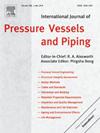Digital twin based predictive diagnosis approach for submarine suspended pipelines
IF 3
2区 工程技术
Q2 ENGINEERING, MECHANICAL
International Journal of Pressure Vessels and Piping
Pub Date : 2025-01-28
DOI:10.1016/j.ijpvp.2025.105451
引用次数: 0
Abstract
Subsea pipelines are vital to offshore oil and gas production systems, with submarine suspended pipelines being the most prone to accidents. Therefore, predictive diagnosis of these pipelines is critical. Traditional inspection methods, though widely studied, fail to offer long-term and multi-directional diagnosis. To address this, the paper introduces digital twins for enhanced predictive diagnosis. A unit-level digital twin framework for submarine suspended pipelines is proposed, leveraging digital twins' capabilities in real-time monitoring, failure prediction, and optimization. Predictive diagnosis, however, requires insights into the pipeline's future condition. Thus, a PFD-TCN (Polynomial Fitting Denoising Temporal Convolutional Network) model is introduced, combining TCN with a polynomial fitting function for noise reduction. This model reduces prediction error by over 50 % compared to traditional TCN models, significantly improving the accuracy of pipeline strain forecasting. Importing real-time and predictive data into the digital twin enables real-time tracking of pipeline dynamics and fault evolution, facilitating further diagnostic analysis within the twin framework. The integration of fault diagnosis and digital twins establishes a novel predictive diagnosis approach for subsea pipelines. In conclusion, the predictive diagnosis system can provide a guarantee for the safe production of offshore oil and gas.
基于数字孪生的海底悬空管道预测诊断方法
海底管道对海上油气生产系统至关重要,海底悬浮管道是最容易发生事故的管道。因此,对这些管道进行预测性诊断至关重要。传统的检测方法虽然被广泛研究,但无法提供长期和多方位的诊断。为了解决这个问题,本文引入了数字双胞胎来增强预测诊断。利用数字孪生在实时监测、故障预测和优化方面的能力,提出了一种单元级海底悬浮管道数字孪生框架。然而,预测性诊断需要深入了解管道的未来状况。因此,引入了PFD-TCN(多项式拟合降噪时间卷积网络)模型,将TCN与多项式拟合函数相结合进行降噪。与传统TCN模型相比,该模型的预测误差降低了50%以上,显著提高了管道应变预测的精度。将实时和预测数据导入数字孪生,可以实时跟踪管道动态和故障演变,从而促进孪生框架内的进一步诊断分析。将故障诊断与数字孪生相结合,建立了一种新的海底管道预测诊断方法。综上所述,该预测诊断系统可以为海上油气的安全生产提供保障。
本文章由计算机程序翻译,如有差异,请以英文原文为准。
求助全文
约1分钟内获得全文
求助全文
来源期刊
CiteScore
5.30
自引率
13.30%
发文量
208
审稿时长
17 months
期刊介绍:
Pressure vessel engineering technology is of importance in many branches of industry. This journal publishes the latest research results and related information on all its associated aspects, with particular emphasis on the structural integrity assessment, maintenance and life extension of pressurised process engineering plants.
The anticipated coverage of the International Journal of Pressure Vessels and Piping ranges from simple mass-produced pressure vessels to large custom-built vessels and tanks. Pressure vessels technology is a developing field, and contributions on the following topics will therefore be welcome:
• Pressure vessel engineering
• Structural integrity assessment
• Design methods
• Codes and standards
• Fabrication and welding
• Materials properties requirements
• Inspection and quality management
• Maintenance and life extension
• Ageing and environmental effects
• Life management
Of particular importance are papers covering aspects of significant practical application which could lead to major improvements in economy, reliability and useful life. While most accepted papers represent the results of original applied research, critical reviews of topical interest by world-leading experts will also appear from time to time.
International Journal of Pressure Vessels and Piping is indispensable reading for engineering professionals involved in the energy, petrochemicals, process plant, transport, aerospace and related industries; for manufacturers of pressure vessels and ancillary equipment; and for academics pursuing research in these areas.

 求助内容:
求助内容: 应助结果提醒方式:
应助结果提醒方式:


